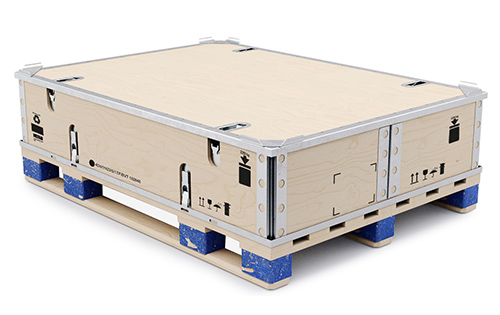Optimal Security: Industrial Packaging Solutions Tailored for Success
Optimal Security: Industrial Packaging Solutions Tailored for Success
Blog Article
Reliable Industrial Recycling Solutions for Lasting Packaging: A Comprehensive Guide
In today's increasingly environmentally-conscious globe, the need for lasting packaging remedies has never ever been greater. To satisfy this demand, companies throughout industries are actively looking for reliable commercial recycling services. Navigating the complicated landscape of lasting packaging can be challenging without a thorough overview. That's where this comprehensive guide on effective commercial recycling solutions for lasting product packaging is available in. By checking out vital locations such as packaging material choice, designing for recyclability, applying reusing facilities, teaming up with recycling partners, and tracking and determining recycling success, this guide will furnish you with the knowledge and devices needed to make informed choices and drive positive modification within your organization. Whether you're a packaging expert, sustainability manager, or merely curious about the topic, this guide will certainly provide beneficial understandings and strategies to help you browse the world of lasting product packaging.
Product Packaging Material Option
The selection of product packaging materials plays a critical function in guaranteeing the sustainability of commercial recycling remedies. When it pertains to sustainable product packaging, the option of materials is type in decreasing ecological influence and taking full advantage of reusing efficiency. Selecting the right materials can help in reducing waste generation, preserve sources, and advertise a circular economic climate.
One crucial variable to take into consideration in product packaging product choice is recyclability - processing company. Materials that can be conveniently reused and included back into the production cycle are favored. For instance, products like cardboard, paper, glass, and specific sorts of plastics can be reused several times without losing their quality. On the various other hand, materials that are difficult to reuse, such as non-recyclable compounds or blended plastics, can create obstacles for the reusing process and might end up in incinerators or landfills.
Another consideration is using eco-friendly and biodegradable products. Packaging made from renewable energies, such as plant-based plastics or biopolymers, can aid decrease dependency on nonrenewable fuel sources and reduce environment adjustment. Additionally, biodegradable products break down naturally gradually, reducing the buildup of waste in garbage dumps.
Furthermore, the weight and volume of product packaging products should be decreased to decrease transport prices and power consumption. Light-weight materials not only need less sources during manufacturing yet also add to reduce carbon discharges during transport.
Designing for Recyclability
Product packaging designers ought to prioritize the use of materials that are commonly accepted for reusing and have actually established reusing frameworks. Products such as glass, aluminum, and particular kinds of plastic, like Animal and HDPE, are generally reused and must be chosen over products that are tough or costly to reuse.
Another crucial consideration in developing for recyclability is the removal of unneeded components or products. By reducing the variety of layers, finishings, and additional parts, packaging can be made simpler and easier to recycle. Furthermore, designers need to aim to lower using combined materials, as they can make complex the reusing process.

Implementing Recycling Facilities
Effective implementation of reusing infrastructure is critical for the success of industrial reusing solutions. Without appropriate framework in position, the reusing process ends up being inefficient and ineffective, hindering the general objective of sustainable packaging.
To apply recycling infrastructure efficiently, numerous vital aspects require to be considered. First of all, there need to be an efficient collection system that promotes the separation and collection of recyclable materials. This can include assigned reusing containers in public rooms, in addition to collaborations with waste management business for curbside pickup and sorting.
When collected, the recyclable products require to be moved to reusing centers in a prompt way. This calls for reliable logistics and transport networks, ensuring that the products get to the proper centers right away.
At the reusing centers, progressed sorting and processing innovations must be in location to separate different kinds of products properly. This consists of making use of automated sorting equipments, optical scanners, and manual sorting techniques.
Furthermore, there should be a robust market need for recycled materials. This can be achieved through collaborations with manufacturers and sectors that make use of recycled materials in their manufacturing procedures. Producing a stable market for recycled products incentivizes the reusing sector and promotes the round economic situation.
Working Together With Recycling Allies

One secret facet of collaborating with recycling partners is the facility of clear communication networks. It is essential to establish open lines of interaction to assist in the exchange of information, updates, and responses. This enables both events to remain informed concerning the development of reusing initiatives and deal with any kind of difficulties or concerns that may arise.
Additionally, collaboration can entail joint efforts in implementing and developing reusing programs. Recycling companions can offer beneficial insights and assistance in developing effective collection systems and determining one of the most appropriate recycling modern technologies. By interacting, companies and reusing partners can redirected here maximize the recycling process and decrease waste.
Furthermore, cooperation can extend past the operational elements of reusing. It can additionally encompass advocacy and education and learning initiatives. By joining pressures, organizations and recycling companions can raise understanding concerning the importance of recycling and promote the adoption of lasting product packaging techniques among consumers and other stakeholders.
Tracking and Measuring Recycling Success
To make sure the performance of Get More Info commercial reusing solutions and the achievement of lasting packaging goals, it is important for organizations and their reusing companions to develop a thorough system for monitoring and measuring reusing success (processing company). Determining and tracking reusing success enables services to examine the effect of their recycling efforts, determine areas for enhancement, and set significant targets for future progress
One way to track recycling success is through making use of information collection and evaluation tools. By gathering data on the amount of packaging waste created, the percent of waste that is recycled, and the kinds of materials being reused, organizations can obtain useful insights into their recycling efficiency. This information can then be analyzed to recognize fads, patterns, and locations of inefficiency.
Another crucial facet of monitoring and gauging recycling success is establishing clear and standard metrics. This permits organizations to contrast their performance versus market benchmarks and track their development in time. Metrics such as recycling prices, waste diversion rates, and greenhouse gas exhausts can give a quantitative procedure of an organization's reusing success.

Verdict
To conclude, implementing efficient industrial recycling solutions for sustainable product packaging needs careful factor to consider of product packaging material option, designing for recyclability, implementing reusing facilities, working together with reusing partners, and monitoring and measuring reusing success. By integrating these techniques, services can contribute to an here are the findings extra environmentally-friendly and lasting approach to product packaging, decreasing waste and advertising the circular economic situation.
By exploring vital areas such as product packaging product choice, designing for recyclability, carrying out recycling facilities, collaborating with recycling companions, and tracking and determining reusing success, this guide will furnish you with the understanding and tools needed to make enlightened decisions and drive favorable adjustment within your organization. Product packaging developers ought to focus on the usage of products that are widely accepted for reusing and have actually established recycling infrastructures.Cooperation with reusing partners is necessary for the effective implementation of industrial recycling options and the success of sustainable packaging goals. By joining pressures, services and recycling companions can elevate understanding about the significance of recycling and promote the adoption of sustainable product packaging techniques amongst customers and various other stakeholders.
By accumulating data on the quantity of product packaging waste created, the percent of waste that is reused, and the kinds of products being reused, organizations can gain valuable insights into their reusing efficiency.
Report this page